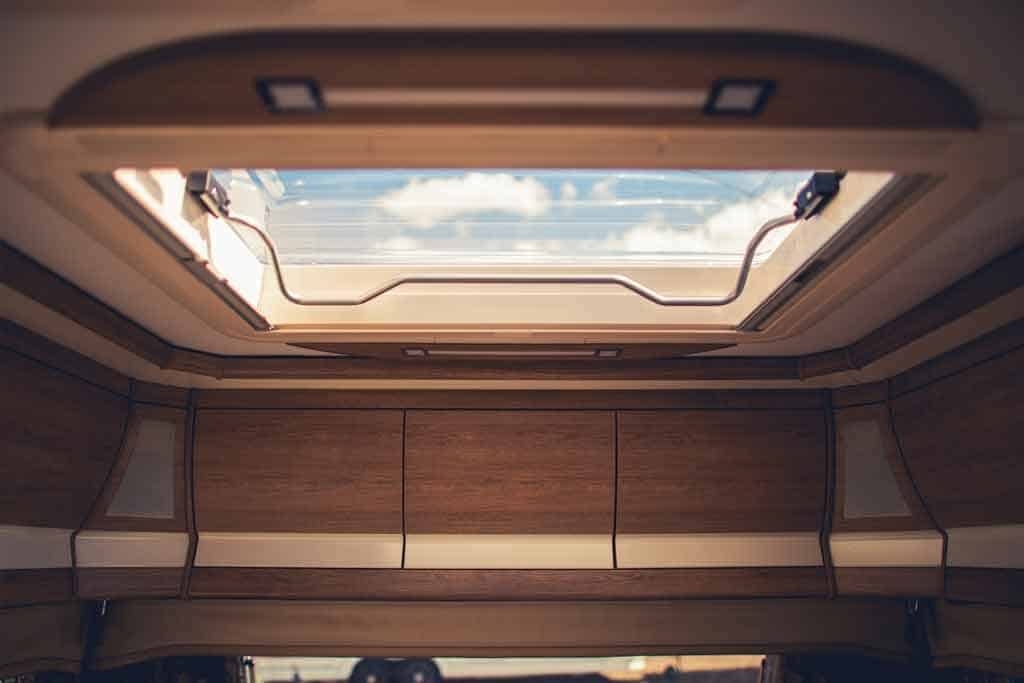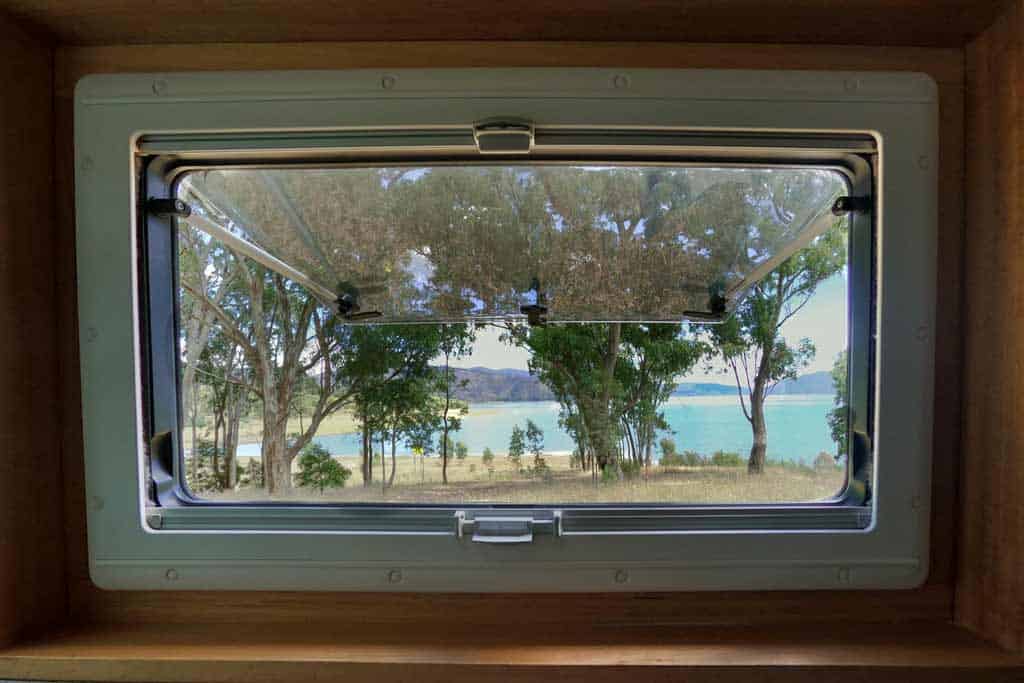Plan your van build by putting campervan ventilation at the forefront. Find out why ventilation is so important and how you can make the best decisions regarding airflow.
Campervan ventilation is one of the most important considerations when it comes to your camper van conversion and can be the difference between an amazing experience, and a terrible one.
This sounds a bit excessive, right? Surely it can’t make that big of an impact on your nomadic lifestyle on the road. This couldn’t be further from the truth.
Campervan ventilation is one of, if not the most important aspects for maintaining a comfortable environment within your camper van. This means keeping fresh air circulating and getting rid of any foul odors and stale air inside the van.
It also helps to control the temperature inside the van, ensures that there is enough ventilation, and also helps to prevent condensation. Campervan heating and cooling also go hand-in-hand with this and should be equally considered when fitting out your camper van.
In this post, we will look at some of the most important reasons why ventilation, heating, and cooling are so important as well as how to properly ventilate a camper van. We hope that this post comes in handy to you as you embark on your adventure-driven lifestyle and make the road your home.
Campervan Ventilation – Why Ventilating Your Campervan Is Important
The biggest reason for a camper van requiring proper ventilation comes down to the fact that it’s a confined area. Space is extremely limited and it can become incredibly stuffy inside your van incredibly quickly.
You want fresh air coming into your van for you to breathe in and generally be in a fresh, clean environment.
At the same time, you want to get rid of foul, stuffy, and smelly air that arises from general breathing, body odor, and cooking. This will ensure that you have a comfortable environment to live in while on the road.

Comfort inside
Ultimately you want to create a comfortable environment inside your camper van by ensuring you have proper air circulation and adequate ventilation within.
As we mentioned previously, the inside of a van is such a confined space compared to a house that can become stuffy and smelly really quickly.
Fight humidity, condensation, and mildew
Campervan ventilation will help to fight humidity within the van as well as prevent condensation and mildew from occurring. Condensation and mildew will give you endless nightmares and can lead to much bigger problems in the long run.
Although mold can be taken care of in the short term, if condensation gets into your woodwork it can cause rotting and weaken structural elements.
Defeat odor
By having a constant flow of fresh air into your van, you will also be able to defeat any foul odor that might occur as a result of bodies or cooking. Aside from these two factors, having a furry friend with you will also add to the odors within the van as well as any dirty laundry that isn’t confined in a plastic bag.
Another point to note is that these odors can be compounded by heat. If there is too much hot air and not enough cold air in your van, you will tend to sweat more which will further add to the foul odors.
What to know about condensation in a van
Understanding condensation is an incredibly important aspect of campervan ventilation and maintaining a comfortable environment within your van. Condensation is the process during which water vapor is changed into liquid form.
This happens when warm, moisture-laden air comes into contact with a colder surface. When this happens, the water vapor changes to a liquid and starts to collect on surfaces within the van.
There are a number of different sources of this warm, moisture-laden air within the van as listed below:
Breathing
When you breathe out, you expel warm air. In the confines of your van, unless properly ventilated, this warm air has nowhere to go. This occurs both when we are awake and while we are asleep, although far more warm, moist air is created while we are awake.
This inhalation and exhalation will create humidity within your van and will ultimately add to the factors creating condensation.
Showering
If you are one of the lucky ones to have a shower inside your van, then you’re unfortunately going to have to deal with condensation. Hot water showers will create steam which is warm air with a high moisture content and this is another factor that will cause condensation.
If you don’t have the luxury of a shower inside of your van then this problem won’t affect you. Although many people do, so it is an important factor to address when building your van.
Related: Check out our post on how to find showers near you so you can skip the shower in your van!
Cooking
Cooking inside your van is going to cause heat and humidity, from a full-on cook-up to simply boiling water. It is one of the fastest ways to create warm, moist air inside your van and ultimately, condensation.
Unless the weather is terrible, always try and keep the cooking outside the van to prevent this from happening. A good rule is to keep the living space and the cooking space separate in order to prevent this from happening.
It isn’t always possible, especially during the winter, but try to live by this rule.
Related: Check out these campervan kitchen setups to get an idea of how to cut down on ventilation needs.

natural gas cookers
There are cooker tops and stoves that make use of natural gas to create flame and generate heat. They emit a large amount of water vapor that will ultimately condense.
This comes down to the process of oxygen, carbon dioxide, and natural gas combusting. Combustion is a chemical process during which a substance, in this case, natural gas, reacts rapidly with oxygen and gives off heat. The most common natural gas that is used is propane.
wet clothes and equipment
Any form of damp or wet clothing, towels, and equipment will generate moisture. Try to keep these items outside, if the weather permits it. Hang them out to dry when the weather is good so that you can pack them away and not have to worry about them creating moisture.
There are a number of condensation hotspots inside a van, that are usually non-insulated and conduct heat. These are as follows:
- Windows
- Metal panels and surfaces inside your van
- Furniture within your van
- Your van roof/ceiling
There are a number of problems that will arise from condensation occurring inside your van. While small amounts of condensation will occur no matter how much you try to avoid it, as long as it’s controlled, it won’t lead to major problems.
Fungi/mold
If untreated, condensation can cause fungi/mold growth to occur within your van. Not only is this unattractive to look at, it can lead to respiratory issues, especially for those who are susceptible to such conditions.
Bacteria can also arise from this which can become dangerous as one could develop an allergic reaction to it.
dust mites
Another issue that can arise is the development of dust mites. Condensation can create the perfect environment for dust mites to thrive. These critters can also lead to respiratory issues as well as asthma due to there being excess moisture in the air.
foul odors
Lastly, foul odors can develop as a result of untreated condensation over an extended period of time. This can be due to a constant damp/wet smell or bacteria and mold growth that has caused some form of rotting.
the solution
At the end of the day, the only real way to curb these issues, in the long run, is through good ventilation within your van. A good campervan ventilation system, together with a well-insulated van, can effectively manage humidity and water vapor inside your van and ultimately limit and prevent condensation from occurring.
Now let’s take a look at how to properly ventilate your van as well as a few different methods of achieving this. It is recommended to check out articles such as this one and to do extensive research with regard to your camper van conversion to achieve the best possible results.
How to properly ventilate a campervan
We’re now going to discuss the various methods to properly ventilate your campervan before setting off on your van life adventure. It is important to note that the various methods can be broken down into active and passive.
Passive
Passive ventilation is a simple concept. As the name suggests, it doesn’t require a power source from your van in order to function.
It works by means of natural air currents. Hot, stale air leaves your van through a passive air vent, while cooler, fresh air is pulled in. It’s a simple scientific concept and usually doesn’t require too much effort or cost.
The downside to passive ventilation is that on a hot day, there isn’t much difference in the air temperature and pressure on the inside and outside of your van. This means that passive methods of ventilation won’t be as effective and you’ll need to switch to an active method.
The various options for passive ventilation are as follows:
Windows
Opening your windows is by far the easiest way to circulate air within your van and to get fresh air from the outside, in. You don’t need to make any alterations to your van in any way – you simply roll down the window(s) and you have fresh air at your leisure.
While this is the easiest way to ventilate your van and has zero additional cost, it isn’t necessarily the most effective. It should really only be seen as a temporary solution for ventilation and not for the longer term.
The downside to this form of ventilation is that it’s not wise to do so at night. It’s a security risk and the possibility of getting broken into is quite high.
It’s also a potential problem if the weather changes for the worse as rain or snow could enter your van, as well as sand and debris if it gets windy.

Wind Deflectors
Wind deflectors are a great system to use in conjunction with an open window – they conceal a slightly open window so that it hides the fact that they are open ever so slightly.
Again, they don’t require any alterations to your van – you simply install them above your van’s window.
The downside is that your windows still need to be open for them to function which is, once again, a security risk.
They also rely on airflow to function which isn’t majorly effective as you can’t make the wind blow and you can’t always park in an orientation that promotes airflow.
Although still not the most effective system, they are better than simply opening your window as they channel more fresh air into your van. Many generic options are available on the market for all major car brands.
Bug Screen on Your Door
A bug screen allows a much larger area to attract fresh air into your van, especially if installed across the rear door as it’s a large space.
But again, security risks and relying on natural airflow are potential issues.
They are great for summertime if you wish to have your door open while you sit inside your van and watch an episode of your favorite series while still awake. It will keep fresh air flowing and the fly and crawling critters out – a win-win.

Louvred Air Vents
Louvred air vents are a great, inexpensive ventilation system for your van. Fitting louvred air vents is pretty simple to do by yourself and many have a manual open/close mechanism making them easy to use. You can also install floor vents for additional ventilation.
Again, they rely on airflow and movement to function, so without it, they don’t function to their full capacity. They can also take away from the aesthetic of your van and give it a commercial feel.
Another issue that adds to their cost is the need for a fly/bug sheet behind every vent. This is a definite requirement to keep bugs and insects at bay due to the large openings.
Wind-Driven Roof Vent
Wind-powered roof vents are by far the most effective of the passive ventilation systems. They are the most secure system as they are factory manufactured and are relatively inexpensive and easy to install.
These wind-driven roof vent systems are also fully waterproof and are a lot more secure, making them a great additional option to have in your van.
Again, they rely on manual airflow so you are at the mercy of mother nature to provide you with enough wind for them to function effectively.
The internal bearing can also become seized if it isn’t properly maintained, so some maintenance is required on a regular basis to keep it functioning at its optimal level.
Active
The major difference here is that forms of active ventilation will require a power source from your van or an external electrical source. While they require power, they don’t require natural air temperature and pressure differentials to function.
This makes them a lot more reliable and they can be used whenever you like, provided there is power. The various options for active ventilation are as follows:
Powered Roof Vents
A powered roof vent is one of the most effective methods to ventilate your van. This form of campervan roof vent uses power either from your van itself or from an external power source.
This ventilation system is by far the best way to move air into and out of your camper van. They are relatively secure and reduce the risk of breaking and entering your van. But the best part about them is that you can use them while you are stationary.
For an even better performance, it is recommended that you install two in a series. The first one functions to draw cold air in, while the second one pushes hot air out.
While this is by far the most effective ventilation system, it does come with some shortfalls. It is also the most expensive way to ventilate your van and it also requires significant modifications to it, often requiring cutting large holes in the roof.
If not done properly, this can lead to further issues such as water leaks so it’s best to get these vents installed by a professional.
Read More: Here’s our post on the best van roof vents on the market.
Air Conditioner/AC Unit
An air conditioning system is one of the best ways to avoid the problem of hot air in your van. An air conditioner will push cooler air into your van to create a comfortable internal environment. There are a number of different AC units available such as a portable AC unit or a window AC unit, depending on your needs.
They can be quite pricey, but comfort is key when traveling on your van life adventure and the internal temperature of your van is of the utmost importance.
Read Next: Check out our review of all of the best van air conditioning options out there!
Portable Fans
The last recommended option for ventilation is a simple portable fan, either 12V or a USB one. Both of them can function without the need for electricity and are a simple, inexpensive way to get the air flowing in your van’s interior space.
Final Words
We hope that this guide helps you in ventilating your campervan in the most efficient and cost-effective way. While it’s possible to install ventilation systems yourself, if it is too specialized or out of your capabilities, then get it done by a professional.
The last thing you want is to create additional problems for yourself. Another important consideration is to get your van properly insulated by means of foam board insulation in order to combat condensation issues from occurring.
This post may contain affiliate links. That means if you make a purchase a product we recommend using the links in this article, we may receive a small commission at no extra cost to you. We promise to use this pocket money to buy lots of coffee and fuel for the campervan to keep us enjoying #VanLife for just a little longer. We appreciate your support, and only recommend products we know and trust. Thank you friends!





